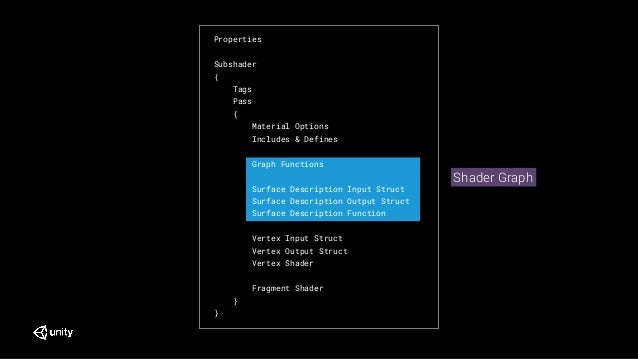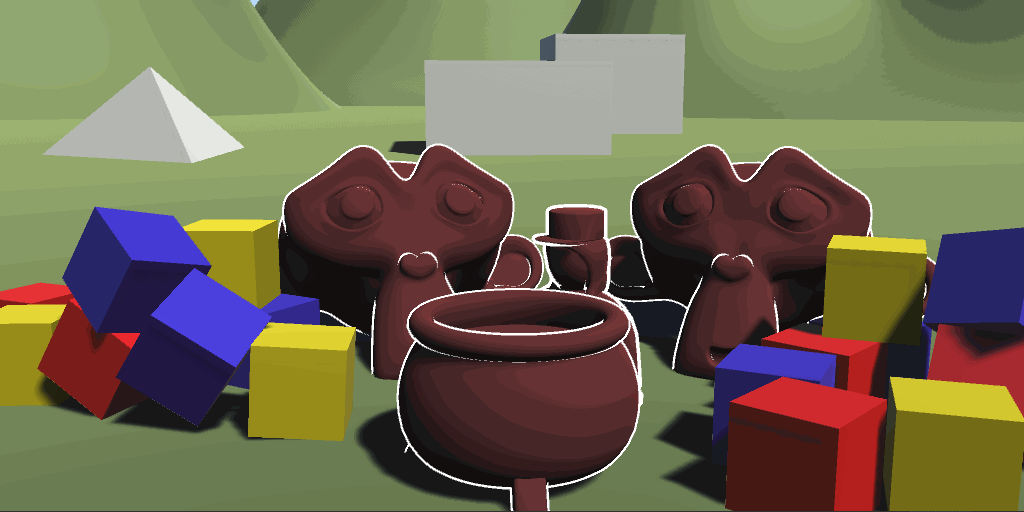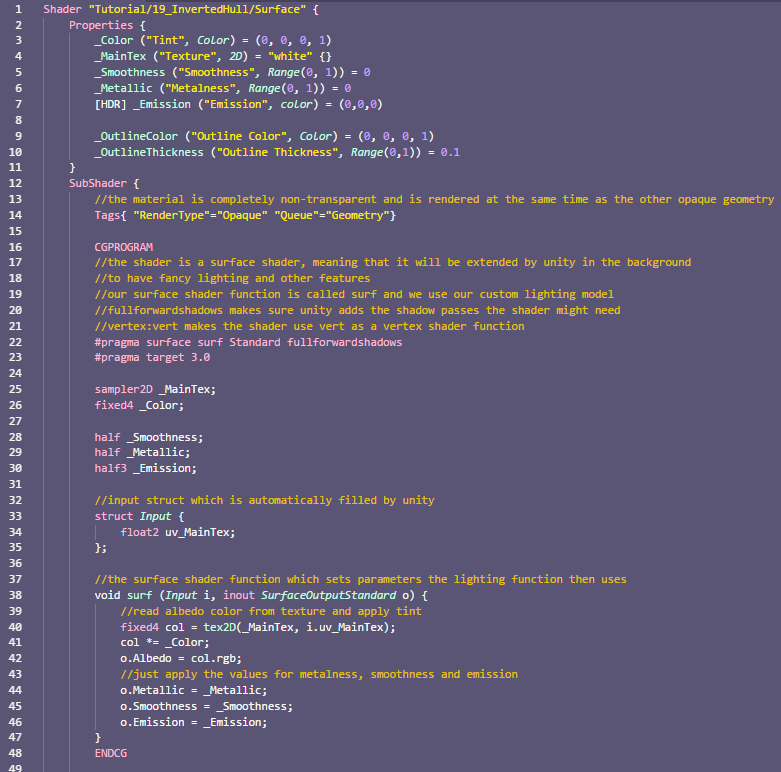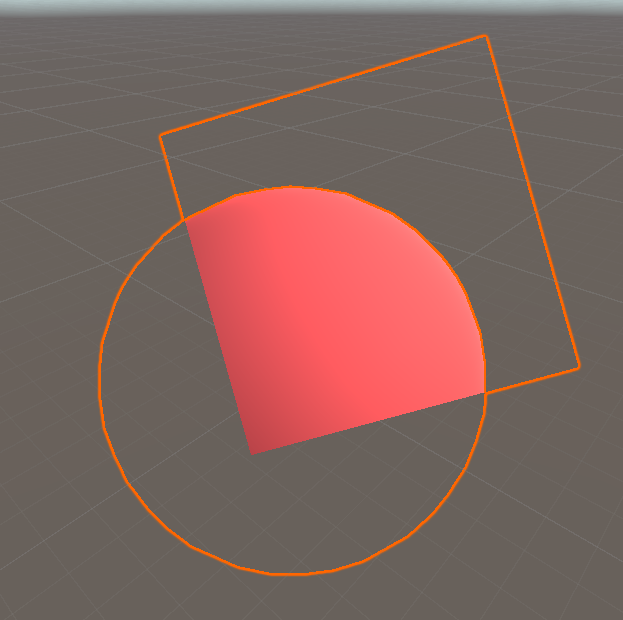[最も人気のある!] unity shader pass example 130245-Unity multi pass shader example
For some examples, take a look at Vertex and Fragment Shader Examples The rest of this page assumes shaders do not interact with Unity lights (for example special effects, postprocessed effects etc) Shader programs are written in HLSL language, by embedding "snippets" in the shader text, somewhere inside the Pass commandUnity 4x Shaders Transparent Single Color Shader A shader that fills polygons with a single color and supports transparency For text meshes or as a basis for other GUIrelated shaders16/5/13 · DepthMaskshader in use on the example project This shader draws faces which are invisible, but which still appear in the depth buffer This allows you to prevent objects from being drawn where they are occluded by the mask To understand how this technique works, you should know about the depth buffer and render queues before reading further

Unity Srp Surface Shaders Unity Forum
Unity multi pass shader example
Unity multi pass shader example-Adding an extra Pass to the Unity Standard Shader 1 I'm experimenting with adding some procedural textures to the unity standard shader I'd like to add an extra pass (with vert and frag functions), but am unsure about where in the sequence this should go, and how to properly integrate it with the other passes (I want to keep all the standardHere are some examples of Surface Shaders The examples below focus on using builtin lighting models;



Creating A Shader In Unity Simple Talk
Shader "Test/CustomShader" { Properties { _Color ("Color", Color) = (1,1,1,1)Unity Simple "pass through" geometry shader Ask Question Asked 3 years, 11 months ago And, as I said, if the geometry shader is "out", I see them Now i want to dive into the geometry shader and make, for example, quads out of the points given from the compute shader And obviously something is wrong with my geometry shader,Unity 5x Shaders Lux an open source shader framework ;
For example, to create a menu button with highlight effect (which has our custom shader) masked by a frame, follow these steps Create a frame (Canvas) and put your buttons inside Create a shader which accepts custom parameters as the Highlight color;0 I think you may need to duplicate the shader, but without the pass you want to skip Then just swap between as needed For reference here is an example of how you could swap a shader within a monobehaviour RequireComponent (typeof (Renderer)) public class ShaderSwapExample MonoBehaviour { void Start () { Shader TransDiffuseShader7/12/13 · I love Unity – it's one of those environments that's actually a pleasure to program in, but its terrain system seems somewhat lacking behind its other features, requiring quite a lot of hacks and workarounds to get desired appearance and functionality (while still having an acceptable level of performance) For example, at first glance, the
When used in forward rendering additive pass, Fog needs to fade to black color, and this example handles that as well with a check for UNITY_PASS_FORWARDADD Shader "Example/Fog via Final Color" { Properties { _MainTex ("Texture", 2D) = "white" {} _FogColor ("Fog Color", Color) = (03, 04, 07, 10) } SubShader { s { "RenderType" = "Opaque" } CGPROGRAM #pragma surfaceFor example, the Standard shader that Unity provides (or URP/Lit, HDRP/Lit), can replicate many basic materials fairly well (eg plastic, metal, wood, stone, etc) with the correct texture maps and other values (Albedo, Normal, Occlusion, Metallic/Specular, etc) Setting Properties from C#3/1/17 · Unity GPU Instancing Unlit Instanced Shader Unity GPU instancing allows you to duplicate meshes without using much CPU overhead, which means you can render more cubes or more copies of trees, fishes, fractal geometries, or whatever else you can dream up!



Creating A Shader In Unity Simple Talk



Writing Shader Code For The Universal Rp Page 2 Cyan
15/10/ · Official Shaders Source Here you can get the sourcecode for all the shaders that are built into Unity;The first example shader will write the value '2' wherever the depth test passes The stencil test is set to always pass Shader "Red" { __SubShader__ Each shader in Unity consists of a list of subshaders When Unity has to display a mesh, it will find the shader to use, and pick the first subshader that runs on the user's graphics cardThe initial examples you are going to use are a plane and a camera pointing at the plane to show the different functionality of the fragment shaders The setup of the plane and the camera is explained, moreover the shaders can work with any geometry without major modifications Configuring a Unity Project



Shader Graph Tutorial For Beginners A Complete Introduction Codinblack



My Take On Shaders Grab Pass Distortion Harry Alisavakis
You can read more at in the Unity 55 documentation on GPU InstancingUnity Combining Passes in Shader I have a shader which uses multiple passes to determine the thickness of an object at each point I want to use this thickness value in order to sample from a texture, which will determine the color of the screen at that pointVertex and Fragment Shader Examples This section describes how to setup a basic scene in Unity that you can work with The initial examples you are going to use are a plane and a camera pointing at the plane to show the different functionality of the fragment shaders The setup of the plane and the camera is explained, moreover the shaders can



Shader Graph In Unity For Beginners Raywenderlich Com



Unity Shader Highlighting Overlaps Stack Overflow
For example, you could have one subshader for desktops and another for mobiles We need just one subshader block Shader "Custom/My First Shader" { SubShader {}} The subshader has to contain at least one pass A shader pass is where an object actually gets rendered We'll use one pass, but it's possible to have moreI'm writing a shader in CG language for Unity3d If you make a shader for transparent object you need to create two similar passes in SubShaderThe first one to render only back faces (with Cull Front) and the second one to render only front faces (with Cull Back)But the code for vertex and fragment function is the same for two passesExamples on how to implement custom lighting models are in Surface Shader Lighting Examples Simple We'll start with a very simple shader and build up on that Here's a shader that just sets surface color to "white"



Rendering 2



Shader Pass And Multi Pass Shader Codinblack
All Shader files in Unity are written in a declarative language called ShaderLab In the file, a nestedbraces syntax declares various things that describe the shader – for example, which shader properties to show in the Material Inspector A Unity window that displays information about the currently selected GameObject, asset or project settings, allowing you to inspect and edit the// For example, when depth texture is on, we need to perform this offscreen depth prepass for this toon shader Pass {Name "DepthOnly" s {"LightMode" = "DepthOnly"} // more explict render state to avoid confusion ZWrite On // the only goal of this pass is to write depth!UPDATE – there is now a post up on how to set up a geometry shader in URPThe steps are a little different than what's described in this article, as this was focused on the legacy renderer There's also a youtube version of that URP article I've been working on a shader tutorial for paper in Unity Burning it, folding it, those sorts of things


Wphfw3gu6 Ce0m



Custom Render Passes With Urp Unity Learn
5/6/ · Instead of writing out an entire pass, it's possible to just use a pass from a different shader Note that the name gets converted to uppercase internally For example, if we wanted to use this pass in a different shader we could do UsePass "Custom/UnlitShaderExample/EXAMPLEPASS" That pass would then be included in that other shaderZTest LEqual // early exit at EarlyZ stage if possibleSince we're working with DirectX, Unity's compute shaders need to be written in HLSL, but it's pretty much indistinguishable from the other shader languages so if you can write Cg or GLSL you'll be fine (this was my first time writing HLSL too) The first thing you need to do is create a new compute shader



Unity Shader Shader Example Code Detailed Explanation Model Vertex Floating Vertex Up And Down Transition Jitter Effect Programmer Sought



My Take On Shaders Stencil Shader Antichamber Effect Harry Alisavakis



Unity Manual Vertex And Fragment Shader Examples


A Gentle Introduction To Shaders In Unity Shader Tutorial


Unity Products Amplify Shader Editor Templates Amplify Creations Wiki



My Take On Shaders Geometry Shaders Harry Alisavakis



Gamecoderbr Unity Multi Pass Surface Shader



Community Forum View Topic Lwrp Multi Pass Shader



Resolved Lwrp Outline Shader Help Needed Unity Forum



Basic Transparency Ronja S Tutorials



Adding Bloom Glow Effect To Shader Unity Game Engine Stack Overflow


Unity Products Amplify Shader Editor Terrain Shaders Amplify Creations Wiki


Standard Shader With Vertex Colors Unity Forum



Unity Shader Packages Package Control



Unity Manual Vertex And Fragment Shader Examples



Shader To Warp Or Pinch Specific Areas Of A Texture In Unity3d Stack Overflow


Feedback Wanted Shader Graph Unity Forum



Custom Shaders



Unity Manual Gpu Instancing



Shader Pass And Multi Pass Shader Codinblack



Unity Srp Surface Shaders Unity Forum



Introduction To Shaders In Unity Raywenderlich Com


Pixel Perfect Outline Shaders For Unity



How To Write Shaders In Unity Using Hlsl Febucci



Innogames Techblog



Best Practices For Shader Graph



Multipass Shaders Inverted Hull Outlines


Unity Products Amplify Shader Editor Templates Amplify Creations Wiki



Bloom


Unity Products Amplify Shader Editor Template Multi Pass Switch Amplify Creations Wiki



Postprocessing And Image Effects In Unity Shader Tutorial


Github Unitytechnologies Shadergraph Examplelibrary A Library Of Shaders Created Using Unity S Shader Graph



Getting Started With Unity S New Shader Graph Node Based Shader Creator Editor Tutorial 3 Normal Maps Faux Water Effect Animation With Time And Noise



Adding Shadows To A Unity Vertex Fragment Shader In 7 Easy Steps Alastair Aitchison



Create Shader For Styly With Shadergraph In Unity Styly



Shader Pass And Multi Pass Shader Codinblack



Jelly Shader Part 1 Basic Sine Wave



Shader Graph Tiling And Offset 19 3 Unity Learn



Multipass Shaders Inverted Hull Outlines



Unity Vertex Shader And Geometry Shader Tutorial Game Dev Bill


Alpha Textures Without Alpha Cutout Please Help Unity Forum



Vertex And Fragment Shaders In Unity3d Shader Tutorial



Unity Manual Vertex And Fragment Shader Examples



A Lesson Plan For Learning Shaders In Unity By Michael Sanders Medium



Unity Toon Shader Tutorial Roystan



Mrtkstandardshader Microsoft Docs



Mrtkstandardshader Microsoft Docs



Mrtk Standard Shader Mixed Reality Toolkit Documentation


Pixel Perfect Outline Shaders For Unity



Andy Touch Made This Quick Example Uses Lwrp 19 2 Custom Blur Render Pass See The Frame Debugger Capture The Camera S Opaques And Transparents To A Texture And



Shader Part 1 Unitygems



Vertex And Fragment Shaders In Unity3d Shader Tutorial



Community Forum View Topic Lwrp Multi Pass Shader


Shader Forge



Unity Manual Vertex And Fragment Shader Examples


Advanced Graphics Techniques Getting Started



Unity3d Lightweight Rendering Pipeline Lwrp Folk Document Programmer Sought



Unity Outline Shader Tutorial Roystan



Custom Pass High Definition Rp 7 1 8



Ethical Motion Unity3d Quick Tip Multipass Surface Shader



The Most Complicated Nothing Shader Unity 3d Grab Pass Youtube



Artstation Shader Unity Refraction Multi Pass Jose Ivan Lopez Romo



Cel Shading In Shader Graph And Urp



Shaders In Unity



Shader Series 5 Unity Shader Graph Game Dev Bill


Unity Products Amplify Shader Editor Templates Amplify Creations Wiki



Shader Selftuition Stencil Testing In Unity Red Owl Games



Unity Shader Basics Tutorial



Custom Pass High Definition Rp 7 1 8



Shader Graph Image Effects For The Postprocessing Stack Unity Forum



Multipass Surface Shader Or Equivalent Unity Answers



Urp Lwrp Multipass Rendering Simple Example Needed Unity Forum



Combining Several Passes In Shader In Unity Game Development Stack Exchange



Stencil Buffers Ronja S Tutorials



Rendering 3



Urp Lwrp Multipass Rendering Simple Example Needed Unity Forum



Urp Unlit Basic Shader Universal Rp 8 2 0



X Ray Shader Tutorial In Unity Linden Reid



The Scriptable Render Pipeline How To Support Grabpass Unity Forum



Ambient Occlusion Showing Through Unlit Texture Unity3d



Unity Urp Mirror Shader Unitylist



Don T Let The Shaders Scare You Part 2 Shaders In Unity Molo17



My Take On Shaders Grabpass Harry Alisavakis


Feedback Wanted Shader Graph Unity Forum



The Scriptable Render Pipeline How To Support Grabpass Unity Forum



Stencil Shaders The Stencil Buffer Allows Shaders To By ron Hedquist Medium


Verajankorva



Single Pass Particle Render Shader Unity Answers



Outline Shader


Spine Unity Runtime Documentation


コメント
コメントを投稿